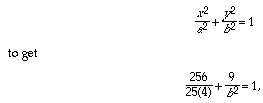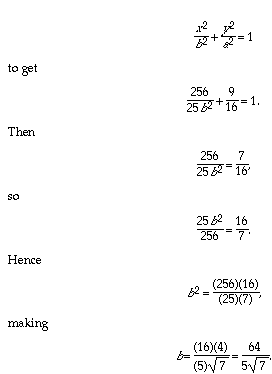Examples of constant sum property
- Let V be one endpoint of the major axis of an ellipse. The distance from V to the nearer focus is the same as the distances from the other endpoint to the other focus. Therefore the sum of distances from V to the two foci is the length of the major axis of the ellipse. Since the sum of distances to the foci from all points on the ellipse is the same, the sum of distances to the foci from all points on the ellipse is the length of the major axis.
Therefore if the length of the major axis of an ellipse is, say, 14, then the sum of distances from all points to the two foci is 14.
- If the rectangular coordinate equation of an ellipse is

- Knowing that the constant sum of distances from any point on the ellipse is, say, 8 does not determine the ellipse. For every value of b < 4 there are two equations

- Besides knowing that the constant sum is 8, if you also knew that the point (16/5, 3) lies on the ellipse, then the ellipse would be determined as long as you assume that the major and minor axes are along the coordinate axes. To find the value of b in the rectangular coordinate equation, you could substitute the known values of x = 16/5, y = 3, and a = 4 and solve. You might try substituting into

but this is impossible because you can't add a positive number 9/b2 to 256/100 to get 1. Therefore the major axis of the ellipse will not be in the x-direction. You need to substitute the known values of x, y, and a into the equation

(This value is approximately 4.838.)
- Choose one focus on an ellipse. Starting from that focus, travel straight to any point on the ellipse, then travel from that point on the ellipse the same distance again, but in a direction straight away from the other focus. What are all possible endpoints of such journeys?
Because of the constant sum property, the distance of each endpoint from the second focus is the constant sum for the ellipse. So the endpoints form a circle whose center is at the second focus and whose radius is that constant sum.












